Haowei Zhu
Accelerating Diffusion-based Super-Resolution with Dynamic Time-Spatial Sampling
May 17, 2025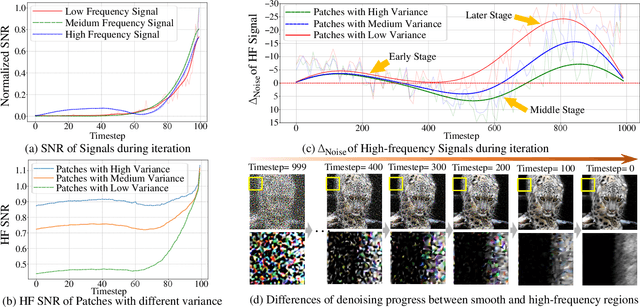
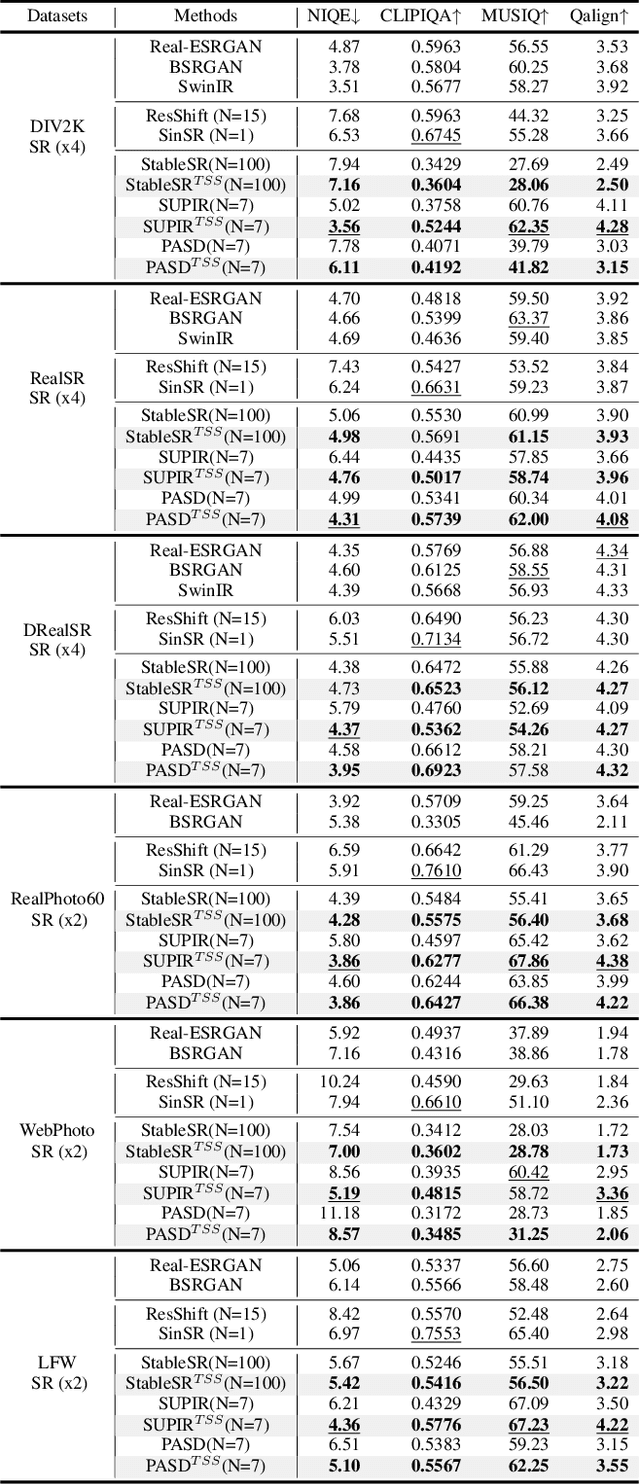
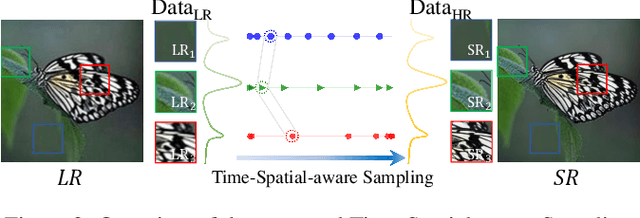
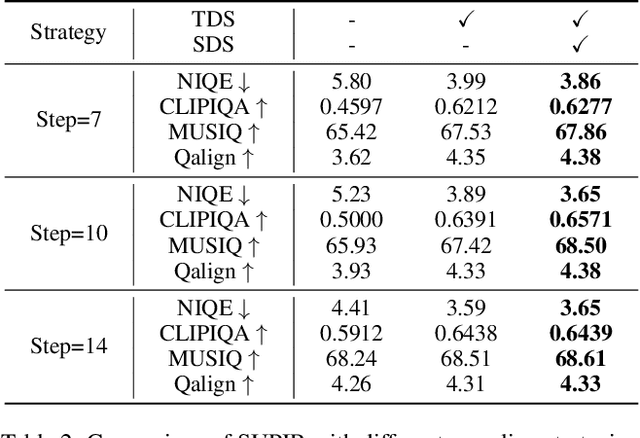
Abstract:Diffusion models have gained attention for their success in modeling complex distributions, achieving impressive perceptual quality in SR tasks. However, existing diffusion-based SR methods often suffer from high computational costs, requiring numerous iterative steps for training and inference. Existing acceleration techniques, such as distillation and solver optimization, are generally task-agnostic and do not fully leverage the specific characteristics of low-level tasks like super-resolution (SR). In this study, we analyze the frequency- and spatial-domain properties of diffusion-based SR methods, revealing key insights into the temporal and spatial dependencies of high-frequency signal recovery. Specifically, high-frequency details benefit from concentrated optimization during early and late diffusion iterations, while spatially textured regions demand adaptive denoising strategies. Building on these observations, we propose the Time-Spatial-aware Sampling strategy (TSS) for the acceleration of Diffusion SR without any extra training cost. TSS combines Time Dynamic Sampling (TDS), which allocates more iterations to refining textures, and Spatial Dynamic Sampling (SDS), which dynamically adjusts strategies based on image content. Extensive evaluations across multiple benchmarks demonstrate that TSS achieves state-of-the-art (SOTA) performance with significantly fewer iterations, improving MUSIQ scores by 0.2 - 3.0 and outperforming the current acceleration methods with only half the number of steps.
Collaborative Multi-Agent Reinforcement Learning for Automated Feature Transformation with Graph-Driven Path Optimization
Apr 24, 2025



Abstract:Feature transformation methods aim to find an optimal mathematical feature-feature crossing process that generates high-value features and improves the performance of downstream machine learning tasks. Existing frameworks, though designed to mitigate manual costs, often treat feature transformations as isolated operations, ignoring dynamic dependencies between transformation steps. To address the limitations, we propose TCTO, a collaborative multi-agent reinforcement learning framework that automates feature engineering through graph-driven path optimization. The framework's core innovation lies in an evolving interaction graph that models features as nodes and transformations as edges. Through graph pruning and backtracking, it dynamically eliminates low-impact edges, reduces redundant operations, and enhances exploration stability. This graph also provides full traceability to empower TCTO to reuse high-utility subgraphs from historical transformations. To demonstrate the efficacy and adaptability of our approach, we conduct comprehensive experiments and case studies, which show superior performance across a range of datasets.
Semantic Hierarchical Prompt Tuning for Parameter-Efficient Fine-Tuning
Dec 24, 2024



Abstract:As the scale of vision models continues to grow, Visual Prompt Tuning (VPT) has emerged as a parameter-efficient transfer learning technique, noted for its superior performance compared to full fine-tuning. However, indiscriminately applying prompts to every layer without considering their inherent correlations, can cause significant disturbances, leading to suboptimal transferability. Additionally, VPT disrupts the original self-attention structure, affecting the aggregation of visual features, and lacks a mechanism for explicitly mining discriminative visual features, which are crucial for classification. To address these issues, we propose a Semantic Hierarchical Prompt (SHIP) fine-tuning strategy. We adaptively construct semantic hierarchies and use semantic-independent and semantic-shared prompts to learn hierarchical representations. We also integrate attribute prompts and a prompt matching loss to enhance feature discrimination and employ decoupled attention for robustness and reduced inference costs. SHIP significantly improves performance, achieving a 4.9% gain in accuracy over VPT with a ViT-B/16 backbone on VTAB-1k tasks. Our code is available at https://github.com/haoweiz23/SHIP.
FTP: A Fine-grained Token-wise Pruner for Large Language Models via Token Routing
Dec 16, 2024Abstract:Recently, large language models (LLMs) have demonstrated superior performance across various tasks by adhering to scaling laws, which significantly increase model size. However, the huge computation overhead during inference hinders the deployment in industrial applications. Many works leverage traditional compression approaches to boost model inference, but these always introduce additional training costs to restore the performance and the pruning results typically show noticeable performance drops compared to the original model when aiming for a specific level of acceleration. To address these issues, we propose a fine-grained token-wise pruning approach for the LLMs, which presents a learnable router to adaptively identify the less important tokens and skip them across model blocks to reduce computational cost during inference. To construct the router efficiently, we present a search-based sparsity scheduler for pruning sparsity allocation, a trainable router combined with our proposed four low-dimensional factors as input and three proposed losses. We conduct extensive experiments across different benchmarks on different LLMs to demonstrate the superiority of our method. Our approach achieves state-of-the-art (SOTA) pruning results, surpassing other existing pruning methods. For instance, our method outperforms BlockPruner and ShortGPT by approximately 10 points on both LLaMA2-7B and Qwen1.5-7B in accuracy retention at comparable token sparsity levels.
DiP-GO: A Diffusion Pruner via Few-step Gradient Optimization
Oct 22, 2024

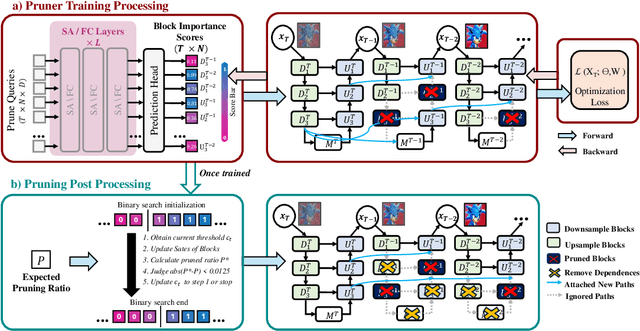

Abstract:Diffusion models have achieved remarkable progress in the field of image generation due to their outstanding capabilities. However, these models require substantial computing resources because of the multi-step denoising process during inference. While traditional pruning methods have been employed to optimize these models, the retraining process necessitates large-scale training datasets and extensive computational costs to maintain generalization ability, making it neither convenient nor efficient. Recent studies attempt to utilize the similarity of features across adjacent denoising stages to reduce computational costs through simple and static strategies. However, these strategies cannot fully harness the potential of the similar feature patterns across adjacent timesteps. In this work, we propose a novel pruning method that derives an efficient diffusion model via a more intelligent and differentiable pruner. At the core of our approach is casting the model pruning process into a SubNet search process. Specifically, we first introduce a SuperNet based on standard diffusion via adding some backup connections built upon the similar features. We then construct a plugin pruner network and design optimization losses to identify redundant computation. Finally, our method can identify an optimal SubNet through few-step gradient optimization and a simple post-processing procedure. We conduct extensive experiments on various diffusion models including Stable Diffusion series and DiTs. Our DiP-GO approach achieves 4.4 x speedup for SD-1.5 without any loss of accuracy, significantly outperforming the previous state-of-the-art methods.
Enhancing Tabular Data Optimization with a Flexible Graph-based Reinforced Exploration Strategy
Jun 11, 2024



Abstract:Tabular data optimization methods aim to automatically find an optimal feature transformation process that generates high-value features and improves the performance of downstream machine learning tasks. Current frameworks for automated feature transformation rely on iterative sequence generation tasks, optimizing decision strategies through performance feedback from downstream tasks. However, these approaches fail to effectively utilize historical decision-making experiences and overlook potential relationships among generated features, thus limiting the depth of knowledge extraction. Moreover, the granularity of the decision-making process lacks dynamic backtracking capabilities for individual features, leading to insufficient adaptability when encountering inefficient pathways, adversely affecting overall robustness and exploration efficiency. To address the limitations observed in current automatic feature engineering frameworks, we introduce a novel method that utilizes a feature-state transformation graph to effectively preserve the entire feature transformation journey, where each node represents a specific transformation state. During exploration, three cascading agents iteratively select nodes and idea mathematical operations to generate new transformation states. This strategy leverages the inherent properties of the graph structure, allowing for the preservation and reuse of valuable transformations. It also enables backtracking capabilities through graph pruning techniques, which can rectify inefficient transformation paths. To validate the efficacy and flexibility of our approach, we conducted comprehensive experiments and detailed case studies, demonstrating superior performance in diverse scenarios.
Distribution-Aware Data Expansion with Diffusion Models
Mar 11, 2024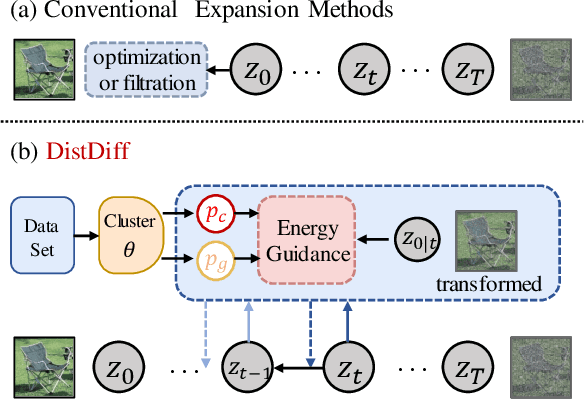

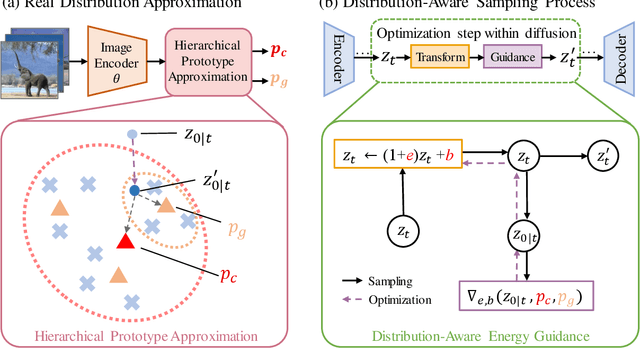
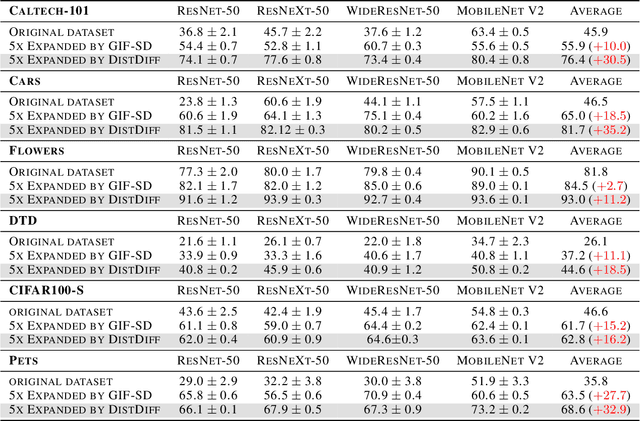
Abstract:The scale and quality of a dataset significantly impact the performance of deep models. However, acquiring large-scale annotated datasets is both a costly and time-consuming endeavor. To address this challenge, dataset expansion technologies aim to automatically augment datasets, unlocking the full potential of deep models. Current data expansion methods encompass image transformation-based and synthesis-based methods. The transformation-based methods introduce only local variations, resulting in poor diversity. While image synthesis-based methods can create entirely new content, significantly enhancing informativeness. However, existing synthesis methods carry the risk of distribution deviations, potentially degrading model performance with out-of-distribution samples. In this paper, we propose DistDiff, an effective data expansion framework based on the distribution-aware diffusion model. DistDiff constructs hierarchical prototypes to approximate the real data distribution, optimizing latent data points within diffusion models with hierarchical energy guidance. We demonstrate its ability to generate distribution-consistent samples, achieving substantial improvements in data expansion tasks. Specifically, without additional training, DistDiff achieves a 30.7% improvement in accuracy across six image datasets compared to the model trained on original datasets and a 9.8% improvement compared to the state-of-the-art diffusion-based method. Our code is available at https://github.com/haoweiz23/DistDiff
Dual Cross-Attention Learning for Fine-Grained Visual Categorization and Object Re-Identification
May 04, 2022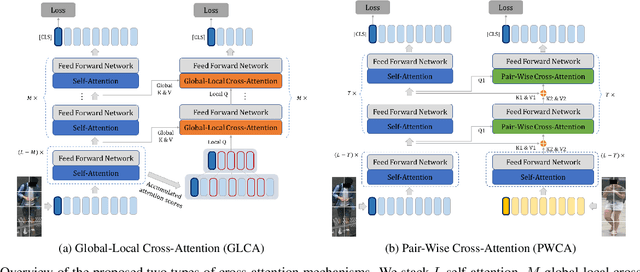
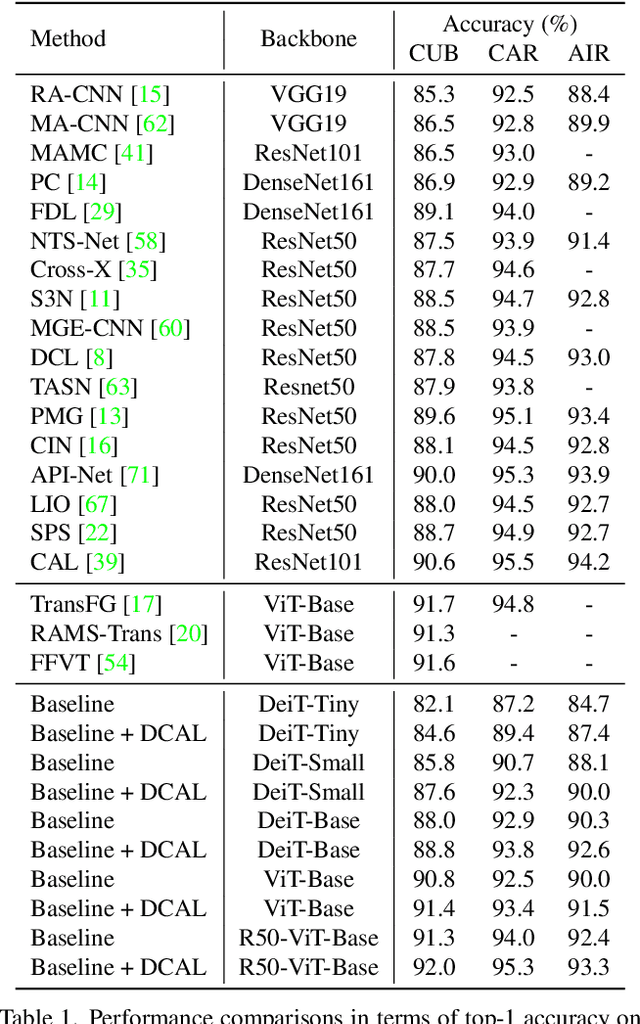
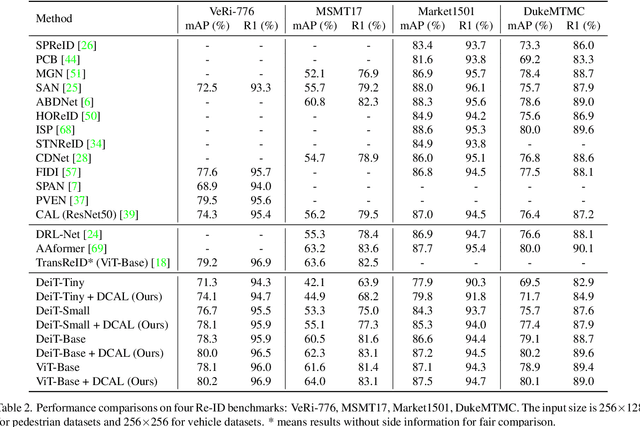
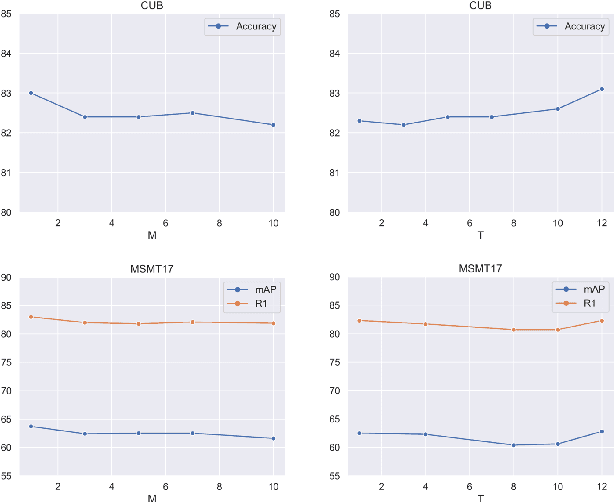
Abstract:Recently, self-attention mechanisms have shown impressive performance in various NLP and CV tasks, which can help capture sequential characteristics and derive global information. In this work, we explore how to extend self-attention modules to better learn subtle feature embeddings for recognizing fine-grained objects, e.g., different bird species or person identities. To this end, we propose a dual cross-attention learning (DCAL) algorithm to coordinate with self-attention learning. First, we propose global-local cross-attention (GLCA) to enhance the interactions between global images and local high-response regions, which can help reinforce the spatial-wise discriminative clues for recognition. Second, we propose pair-wise cross-attention (PWCA) to establish the interactions between image pairs. PWCA can regularize the attention learning of an image by treating another image as distractor and will be removed during inference. We observe that DCAL can reduce misleading attentions and diffuse the attention response to discover more complementary parts for recognition. We conduct extensive evaluations on fine-grained visual categorization and object re-identification. Experiments demonstrate that DCAL performs on par with state-of-the-art methods and consistently improves multiple self-attention baselines, e.g., surpassing DeiT-Tiny and ViT-Base by 2.8% and 2.4% mAP on MSMT17, respectively.
 Add to Chrome
Add to Chrome Add to Firefox
Add to Firefox Add to Edge
Add to Edge